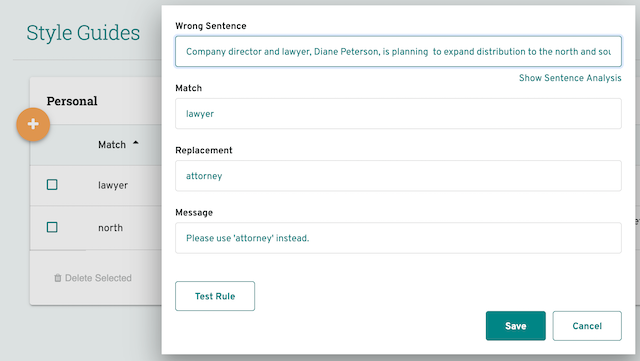
So you’ve put all the blood, sweat, and tears into writing the style guide for your customer service team and it’s finished at last.
Now…how exactly do you get your team to implement it? Who will update it? Where will you store it?
Traditionally, those questions have difficult solutions. Let’s look at how style guides usually work.
The Old Way of Implementing a Style Guide
For most companies, a style guide winds up stored in an intranet document somewhere. It’s on your team to memorize rules or flip back-and-forth to check documents. Team members may look at it once or twice, but forget to reread it regularly for updates.
That’s if the document is updated at all. Maintenance is an overwhelming trial. Most style guides are out of date by the time they’re published. So someone has to schedule regular review sessions. If you’re lucky, you may have one or two team members passionate about language who take on the guide’s upkeep.
But while the updates are necessary, they’re a struggle. The process looks like this:
- Discover you need a new rule
- Open the style guide document
- Determine what category the new rule should fall under
- Navigate to the category (by a table of contents link if you’re lucky, by endless scrolling if you’re not)
- Title the rule
- Write the rule
- Add any exceptions to the rule
- Provide examples
Since customer service depends on keeping response times super-quick, you either spend your precious time prioritizing the guide or answering more support tickets. It’s easy to see how guides get out of date.
Sometimes new rules slip through the cracks. If your team’s seasoned pros edit the guide, they may not realize (and document) what they’ve learned through on-the-job osmosis. So, new hires are still behind, even if they’ve studied your style guide thoroughly.
You could make a system so everyone contributes to the guide routinely. But if you’re not careful about organization, it can easily turn into one mixed-up mess.
Ultimately, the old way of implementing a guide means hours of hard work disintegrate into dusty reference material no one ever uses.
Fortunately, there’s a better way.

The modern way: style guide automation
Despite hand-wringing about AI and robots coming for our jobs, there is one area we have to admit computers are better at: pattern recognition.
Which makes a style guide a natural choice for automation. After all, style guides require nothing more than matching a pattern and correcting it. Here’s a look at all the ways automation gives you an advantage:
Reduces time spent on updates and reviews: Since automated style guides don’t need complex organizational hierarchies, rule creation is a simple add-and-go affair. In a few simple lines, you can add a new rule. Which makes updating a breeze and cuts down on the number of review sessions needed.
Harnesses the collective brain of your team: Automated style guides mean anyone can learn to add rules quickly and easily. Meaning the guide’s upkeep doesn’t fall on the shoulders of your resident language geek. Instead, anyone on your team can add a rule anytime, turning your style guide into a collective knowledge base. So your new hires will always be up-to-date when they join your team.
Decreases editing rounds and extra training: With the old way of implementing style guides, the style check is another manual editing round. Your team might take extra time for longer documents, but they’re unlikely to consider it for the hundreds of support replies they send every day. Unless you’re spending days or even weeks of work hours on training, of course. With an automated style guide, corrections can happen in the flow of work. No extra training or editing rounds needed.
Removes process friction: With the old way of using a style guide, reps needed a physical or on-screen copy of the document open at all times. Adhering to the guide meant referencing and cross-checking each support ticket reply after it’s written. With automated style guides, your team won’t need to juggle an extra checklist item in their workflow. If there’s a problem, your style guide will come to them rather than reps having to actively seek it out. They can answer questions and move onto the next with confidence.
Corrects more consistently: Unfortunately, human nature means we all forget things. In the middle of an interaction with an unhappy customer, Oxford comma usage is probably the last thing on your reps’ minds. When you automate your style guide, the reminders are always on. Meaning you can catch any issues, no matter how quickly your reps have to respond.
Saves your team headaches: If the old way of using style guides sounds like an inconvenience to you, imagine how hard it is on your front-line reps. Extra editing time, worry over missing errors, and the pressure of keeping response times low all add up to a bad employee experience. But just like self-service resources reduce the strain on your team, an automated style guide takes the pressure off.
The modern path to implementation means you and your team can focus on what’s most important: keeping customers happy.
Does an automated style guide replace peer review?
Automated style guides can sound a bit like magic. But you might wonder: can this replace peer review?
Yes and no.
An automated style guide is great for catching smaller errors, especially the ones human eyes unconsciously skip. So the guide can replace nuts-and-bolts discussions of writing mechanics.
But for larger problems, like logical flow and focus on a customer’s question, peer review is still a must. In these cases, nothing can replace the human touch.
The good news is that the automated style guide takes care of the small, nit-picky problems that can add up to poor QA scores. When you’re not having to explain how to use commas in a series, you can look at the deeper issues that will have a greater overall impact.
How do you automate your style guide?
True style guide automation takes an entirely separate tool.
With our tool at ProWritingAid, style guide automation is a few simple lines. All a rule needs is:
- An incorrect sentence
- The incorrect pattern to match
- The correct pattern to suggest
- The reasoning behind the correction
Rules can be added on-the-fly with minimal friction. For a full breakdown of the process, check out our Style Guide 101 article.
You can also see how we automated the “holy grail of style guides” for inspiration on how to automate your guide.
